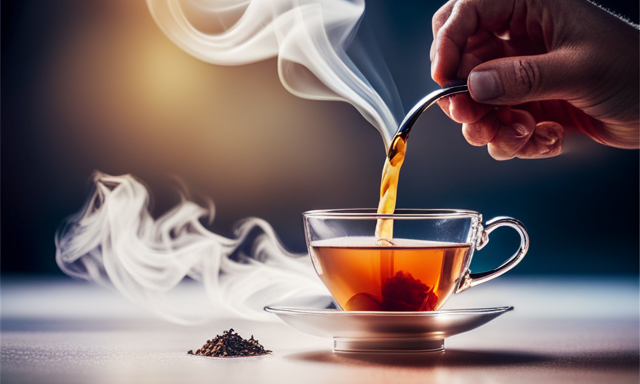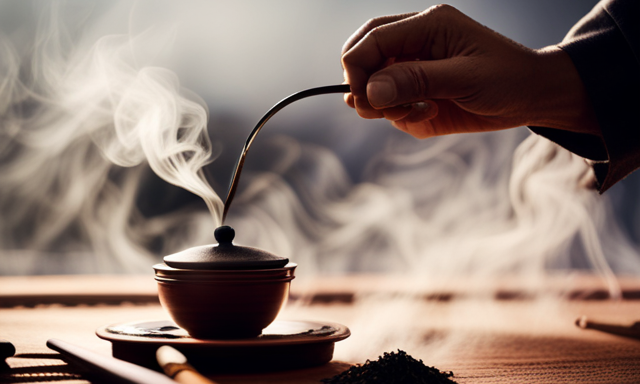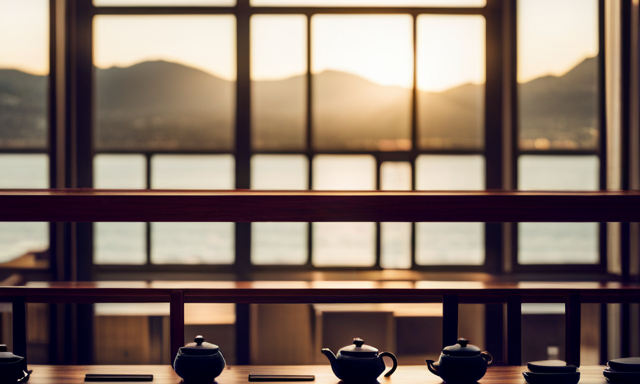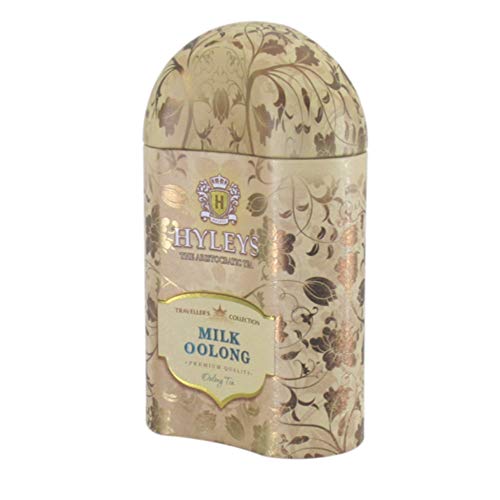Imagine a warm, cozy afternoon, curled up in your favorite armchair, with a steaming cup of roasted oolong milk tea in hand. The earthy aroma of the roasted tea leaves fills the air, while the smooth, creamy milk adds a touch of decadence to every sip.
If you’re like me, a tea enthusiast always on the lookout for new flavors to explore, then this recipe is a must-try. In this article, I will guide you through the process of making this delightful beverage, step by step.
From selecting the perfect oolong tea to roasting the leaves just right, to combining them with creamy milk and sweetening it to perfection, I will share my knowledge and experience to help you create a cup of roasted oolong milk tea that will transport your taste buds to paradise.
So, let’s dive in and indulge in the art of tea making together.
Key Takeaways
- Choosing the right oolong tea is crucial for creating the perfect roasted oolong milk tea.
- Properly rinsing the tea leaves enhances the overall flavor and aroma of the tea.
- Roasting the tea leaves brings out unique flavors and aromas.
- Paying attention to water temperature and steeping time is essential for achieving a delightful cup of roasted oolong milk tea.
Gather the Ingredients
To make the roasted oolong milk tea, you’ll need to gather all the necessary ingredients. Start by accurately measuring the tea to achieve the perfect balance of flavors. Use approximately 2 teaspoons of roasted oolong tea leaves for every 8 ounces of water. It’s important to choose a reputable brand known for its rich and aromatic oolong tea. Once you have the tea leaves ready, focus on steeping techniques. For the best flavor, steep the tea leaves in hot water that’s around 195°F for 3-5 minutes. This will ensure that the full flavor profile of the roasted oolong tea is extracted. With all the ingredients gathered and the steeping techniques in mind, it’s time to move on to choosing the right oolong tea.
Choose the Right Oolong Tea
Once you’ve acquired the perfect oolong tea, your taste buds will embark on a flavor journey that’s bound to leave them dancing with delight.
Choosing the right oolong tea is crucial in creating the perfect roasted oolong milk tea. There are various flavors of oolong tea to explore, each with its own unique aroma and taste profile. From floral and fruity to earthy and nutty, there is an oolong tea flavor to suit every preference.
Additionally, oolong tea offers numerous health benefits, including improved digestion, boosted metabolism, and enhanced mental alertness. Its high antioxidant content can also help reduce the risk of chronic diseases.
Now that you have chosen the right oolong tea, let’s move on to preparing the tea leaves for the next step.
Prepare the Tea Leaves
To prepare the tea leaves for making roasted oolong milk tea, I first measure the right amount of tea leaves. This step is crucial to ensure the perfect balance of flavors in the final beverage.
Once the tea leaves are measured, I then rinse them gently under running water. This helps to remove any impurities and also enhances the flavor of the tea.
Measure the Right Amount of Tea Leaves
When making roasted oolong milk tea, the first step is to ensure you have the right amount of tea leaves. To measure the correct quantity, follow these steps:
- Gather the ingredients: roasted oolong tea leaves and milk.
- Choose the right oolong tea: opt for a high-quality variety with a roasted flavor.
- Prepare the tea leaves: gently crush them to release their aroma.
- Rinse the tea leaves: briefly rinse them with hot water to remove any impurities.
- Roast the tea leaves: heat them in a pan over low heat until they become fragrant.
Knowing the different types of tea leaves and their flavors can help you choose the perfect oolong tea for your milk tea recipe. Oolong tea offers numerous health benefits, including improved digestion and metabolism.
Next, we will move on to the next step: rinsing the tea leaves, which ensures a clean and pure taste in your roasted oolong milk tea.
Rinse the Tea Leaves
To achieve a pure and refreshing taste, it’s important to rinse the tea leaves before brewing your perfect cup of roasted oolong milk tea. This proper technique plays a crucial role in enhancing the overall flavor and aroma of the tea. Rinsing the leaves removes any dust, impurities, or residual pesticides that may be present. It also helps to open up the leaves, allowing them to release their full potential during brewing.
To rinse the tea leaves, simply pour hot water over them in a circular motion and then immediately discard the water. Properly rinsing the tea leaves ensures that your roasted oolong milk tea will have a clean and robust taste.
Now that the leaves are ready, let’s move on to the next step: roasting the tea leaves.
Roast the Tea Leaves
First, you’ll need to roast the tea leaves to bring out their unique flavors and aromas. Roasting techniques play a crucial role in determining the flavor profiles of roasted oolong milk tea. The process involves exposing the leaves to high heat, which helps develop a complex flavor profile with hints of nuttiness and caramelization. Different roasting techniques can result in variations in taste, from light and floral to dark and robust. To guide you through the roasting process, refer to the table below for different roasting techniques and their corresponding flavor profiles.
| Roasting Technique | Flavor Profile |
|---|---|
| Light Roast | Floral, light-bodied |
| Medium Roast | Balanced, smooth |
| Dark Roast | Bold, rich, smoky |
| Charcoal Roast | Deep, toasty, earthy |
| Baked Roast | Nutty, caramelized |
Now that the tea leaves are roasted, we can move on to the next step of heating the milk.
Heat the Milk
To create a truly indulgent beverage, all you need to do next is warm up that creamy goodness.
Begin by heating the milk in a small saucepan over low heat. It’s important to keep a close eye on it to prevent scorching.
As the milk warms up, gently stir it occasionally to ensure even heating.
Once the milk reaches a steaming temperature, remove it from the heat.
Now, it’s time to add some froth to your milk. Using a handheld frother or a whisk, vigorously whisk the milk until it becomes frothy and creamy. This will add a delightful texture to your roasted oolong milk tea.
Now that your milk is perfectly heated and frothed, it’s time to move on to the next step of brewing the tea.
Brew the Tea
To brew a perfect cup of roasted oolong milk tea, it’s crucial to pay attention to two key factors: using the correct water temperature and steeping the tea for the right amount of time.
First, make sure the water temperature is around 195 to 205 degrees Fahrenheit. This allows the tea leaves to release their full flavor without becoming bitter.
Next, steep the tea for approximately 3 to 5 minutes. This ensures a balanced and robust infusion, giving you a delightful cup of roasted oolong milk tea.
Remember, the right water temperature and steeping time are essential for achieving the best flavor. So, take your time and enjoy the process of brewing the perfect cup of tea.
Use the Correct Water Temperature
When making roasted oolong milk tea, it’s important to use the correct water temperature. Choosing the right water temperature is crucial for unlocking the full flavor and aroma of the tea leaves. For roasted oolong, the ideal water temperature is around 195°F (90°C). This temperature allows the tea leaves to infuse properly and release their rich, toasty flavors.
To achieve the perfect water temperature, I recommend using a thermometer to measure the water before brewing. If you don’t have a thermometer, simply bring the water to a gentle boil and let it cool for a minute or two. This will bring the temperature down to the desired range.
Ensuring the correct water temperature sets the foundation for a delicious roasted oolong milk tea. Now, let’s move on to the next step and steep the tea for the right amount of time.
Steep the Tea for the Right Amount of Time
Now, it’s time to let the tea steep just long enough for the flavors to fully develop and create a perfectly balanced cup of deliciousness. The brewing time and tea steeping are crucial to achieving the desired taste and aroma in your roasted oolong milk tea. Here’s what you need to know:
-
Timing is everything: Steeping the tea for the right amount of time is essential. Oversteeping can result in a bitter and overpowering flavor, while understeeping may leave you with a weak and lackluster brew.
-
Follow the instructions: Different types of oolong tea may require varying steeping times. Generally, for roasted oolong milk tea, a brewing time of 3-5 minutes is recommended. However, it’s always a good idea to check the specific instructions provided by the tea manufacturer.
-
Experiment and adjust: The perfect brewing time also depends on personal preference. If you prefer a stronger flavor, you can extend the steeping time slightly. Conversely, if you prefer a milder taste, you can shorten the brewing time.
Now that the tea has steeped to perfection, it’s time to move on to the next step: straining the tea.
Strain the Tea
To strain the tea, I use a tea strainer. This simple tool is essential for removing the tea leaves and ensuring a smooth and sediment-free cup. Properly removing the tea leaves is important to prevent over-extraction and bitterness in the final drink.
Using a tea strainer allows the liquid to flow freely, resulting in a more enjoyable tea-drinking experience. It’s a quick and easy step that ensures a clean and flavorful cup of tea. So, don’t forget to strain your tea before serving to fully appreciate its taste and aroma.
Use a Tea Strainer
Using a tea strainer is essential for creating the perfect roasted oolong milk tea. Here are three reasons why a tea strainer is beneficial:
- Enhanced Flavor: The tea strainer filters out small tea leaves or particles, ensuring a clean and pure taste.
- Smooth Texture: By removing tea leaves or debris, the tea strainer creates a smooth and velvety texture, enhancing the drinking experience.
- Convenience: Using a tea strainer is quick and easy, saving time and effort compared to other alternatives.
While alternative methods like using a fine-mesh sieve or a coffee filter exist, a tea strainer is specifically designed for this purpose, providing the best results.
Now that the tea is strained, let’s move on to the next step of removing the tea leaves properly.
Remove the Tea Leaves Properly
Once the strainer has done its job, it’s time to properly dispose of the tea leaves. Proper technique and the importance of removing all tea leaves cannot be overstated when making roasted oolong milk tea. Leaving even a small amount of leaves can lead to a bitter and unpleasant taste. To ensure a smooth and enjoyable tea, follow these steps to remove the tea leaves properly:
- Hold the strainer over a waste bin or compost container.
- Gently tap the sides of the strainer to loosen any trapped leaves.
- Use a spoon or your fingers to carefully remove any remaining leaves from the strainer.
By removing all the tea leaves, you guarantee a clean and pure flavor in your roasted oolong milk tea. Now that the tea leaves are properly disposed of, it’s time to move on to the next step of mixing the tea and milk.
Mix the Tea and Milk
To mix the tea and milk, it’s important to add the right amount of milk to achieve the perfect balance of flavors. Too much milk can overpower the taste of the tea, while too little may result in a weak and watery beverage.
Once the milk is added, gently stir the tea and milk together to ensure that they are thoroughly combined. This step allows the flavors to meld together, creating a creamy and delightful drink.
Add the Right Amount of Milk
For a creamy and indulgent cup of roasted oolong milk tea, it’s important to add just the right amount of milk. Similar to adding a splash of cream to your morning coffee, the milk creates a velvety smoothness that enhances the rich flavors of the tea.
Here are three key factors to consider when adding milk to your tea:
-
Milk Alternatives: If you prefer non-dairy options, you can use almond milk, soy milk, or oat milk as substitutes. These alternatives can add a unique flavor profile to your tea.
-
Frothing Techniques: To achieve a luxurious texture, you can froth the milk using a milk frother or by vigorously whisking it. This step adds a delightful frothy layer to your tea.
-
Perfect Proportions: The ideal ratio for roasted oolong milk tea is about 1/4 cup of milk for every cup of brewed tea. This ensures that the milk complements the tea without overpowering its distinct notes.
By carefully considering these factors, you’ll be able to create a perfectly balanced roasted oolong milk tea. Now, let’s move on to the next step of stirring the tea and milk together.
Stir the Tea and Milk Together
Blend the creamy milk and fragrant tea together, creating a whirlpool of flavors that meld into a harmonious and satisfying beverage. To ensure the perfect consistency, it is important to choose the right utensils for stirring. A long-handled spoon or a milk frother works best, allowing you to mix the tea and milk thoroughly. Adjusting the tea to milk ratio is another crucial step. Depending on your preference, you can add more tea for a stronger flavor or increase the amount of milk for a creamier texture. Finding the right balance is key to achieving the desired taste. As you stir the tea and milk together, the rich aroma of roasted oolong will permeate the air, creating a sensory experience that is truly delightful. Now, let’s move on to the next step: sweeten to taste.
Sweeten to Taste
To sweeten my roasted oolong milk tea to taste, I first choose the sweetener that best complements the flavors of the tea. Whether it’s honey, sugar, or a natural sweetener like stevia, the choice is up to my personal preference.
Once I have chosen my sweetener, I then adjust the sweetness level by adding it gradually and tasting as I go, ensuring that I achieve the perfect balance of sweetness without overpowering the delicate flavors of the tea.
Choose the Sweetener
Once you’ve picked your favorite roasted oolong tea, it’s time to decide which sweetener will perfectly complement its robust flavors. Here are some options to consider:
-
Honey: With its natural sweetness and floral undertones, honey adds a delightful complexity to your cup of roasted oolong milk tea.
-
Brown sugar: This rich and caramel-like sweetener brings a deep, molasses flavor that pairs exceptionally well with the toasty notes of roasted oolong.
-
Maple syrup: For a touch of earthiness and a hint of sweetness, maple syrup is a great choice. Its distinct flavor adds depth to the tea.
-
Stevia: If you’re looking for a low-calorie alternative, stevia is a suitable option. It provides sweetness without the added calories.
Finding the perfect balance of sweetness is crucial to enhancing the flavors of roasted oolong milk tea. Experiment with different sweeteners and adjust the sweetness level to your preference.
Transitioning into the next section, let’s now explore how to adjust the sweetness level to create the perfect cup of roasted oolong milk tea.
Adjust the Sweetness Level
Finding the perfect balance of sweetness is like harmonizing the flavors of a symphony, allowing the robust notes of roasted oolong to shine in your cup of milk tea. Adjusting sweetness is crucial to achieving that balance. It’s important to carefully consider the amount of sweetener you add, as too little can leave your milk tea bland, while too much can overpower the delicate flavors of the oolong. To help you find the perfect balance, use the table below as a guide:
| Sweetness Level | Amount of Sweetener |
|---|---|
| Light | 1 teaspoon |
| Medium | 2 teaspoons |
| Sweet | 3 teaspoons |
| Extra Sweet | 4 teaspoons |
| Custom | Adjust to taste |
Experiment with different amounts of sweetener until you find the perfect balance that suits your taste. Once you have achieved the desired sweetness, you can move on to the next step of serving and enjoying your delicious roasted oolong milk tea.
Serve and Enjoy!
To serve and enjoy your roasted oolong milk tea, start by pouring the tea into a cup.
Hold the cup with care, ensuring not to spill any of the delicious liquid.
If desired, you can garnish your tea with additional ingredients such as a sprig of mint or a sprinkle of cinnamon.
These optional additions can elevate the flavor and visual appeal of your drink, making it even more enjoyable.
Pour the Tea into a Cup
Now that you have brewed the perfect batch of oolong tea, grab a fancy cup and pour it in with a gentle hand, allowing the aromatic flavors to mingle and dance in anticipation of the creamy milk that will soon follow.
When it comes to serving tea, there are various types of cups to choose from. Traditional teacups with delicate designs can enhance the tea-drinking experience, while modern glass cups can showcase the beautiful color of the tea.
To avoid spills, it is best to pour the tea slowly and steadily, keeping the cup at a slight angle. This allows the tea to flow smoothly without overflowing. Make sure to pour with confidence but not too forcefully. The goal is to fill the cup without creating a mess.
As the tea settles, the next step is to garnish it with additional ingredients (optional).
Transitioning into the next section, let’s explore how to add a touch of flavor and creativity to your roasted oolong milk tea.
Garnish with Additional Ingredients (Optional)
Enhance the flavor and creativity of your cup of oolong tea by garnishing it with additional ingredients, if desired.
Experimenting with different garnishes for your roasted oolong milk tea can add a unique twist to your beverage. Consider adding a sprinkle of cinnamon or nutmeg to bring out the warm and toasty flavors of the roasted oolong tea.
Alternatively, you can try adding a drizzle of honey or a splash of vanilla extract to add a touch of sweetness. For a refreshing twist, consider adding a few fresh mint leaves or a slice of lemon.
To explore creative ways to present your garnished roasted oolong milk tea, you can use a fancy glass or cup and garnish the rim with a sugar or salt rim.
Don’t be afraid to get creative and have fun experimenting with different garnishes to make your roasted oolong milk tea truly unique.
Frequently Asked Questions
How long should I roast the tea leaves for?
The roasting time of the tea leaves greatly impacts the flavor of the tea. It is important to roast the leaves for the right amount of time to achieve the desired flavor profile in the milk tea.
Can I use any type of milk for this recipe?
Sure! When it comes to making roasted oolong milk tea, you have plenty of alternative milk options. From almond to coconut, there are various milk alternatives that can add a unique flavor to your tea.
Can I use a different sweetener instead of sugar?
Yes, there are alternative sweeteners you can use for roasted oolong milk tea. Stevia, honey, or maple syrup are good options. These sweeteners can enhance the flavor while still providing the health benefits of oolong tea.
Can I use a tea bag instead of loose tea leaves?
Using tea bags instead of loose tea leaves for roasted oolong milk tea alters the taste. Tea bags provide convenience and a milder flavor, but lack the complexity and depth that loose leaves offer. Experiment to find your preferred method.
Can I make this tea in advance and store it for later?
Yes, you can make roasted oolong milk tea in advance and store it for later. Brewing and cooling the tea completely before transferring it to an airtight container will help maintain its flavor and freshness.
Conclusion
In conclusion, creating a captivating cup of roasted oolong milk tea is a delightful and delectable endeavor.
By gathering the necessary ingredients, selecting the perfect oolong tea, and skillfully roasting the tea leaves, one can achieve a rich and aromatic brew.
Heating the milk, straining the tea, and expertly mixing the two together creates a harmonious blend of flavors.
Sweeten to your liking and serve this marvelous masterpiece to yourself or share with friends.
Savor each sip and experience the sensational satisfaction it brings.










